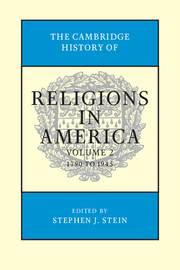Book contents
- Frontmatter
- Contents
- Contributors
- Editor's Introduction
- SECTION I RELIGION IN NORTH AMERICA
- SECTION II RELIGIONS IN THE NEW NATION, 1790–1865
- SECTION III CHANGING RELIGIOUS REALITIES
- SECTION IV RELIGIOUS RESPONSES TO MODERN LIFE AND THOUGHT
- SECTION V COMPARATIVE ESSAYS
- 31 Religion in Canada, 1867–1945
- 32 Religious Developments in Mexico, 1865–1945
- 33 Caribbean Religious History, 1865–1945
- SECTION VI RELIGION AND DIVERSE AREAS
- Index
- References
33 - Caribbean Religious History, 1865–1945
from SECTION V - COMPARATIVE ESSAYS
Published online by Cambridge University Press: 28 July 2012
- Frontmatter
- Contents
- Contributors
- Editor's Introduction
- SECTION I RELIGION IN NORTH AMERICA
- SECTION II RELIGIONS IN THE NEW NATION, 1790–1865
- SECTION III CHANGING RELIGIOUS REALITIES
- SECTION IV RELIGIOUS RESPONSES TO MODERN LIFE AND THOUGHT
- SECTION V COMPARATIVE ESSAYS
- 31 Religion in Canada, 1867–1945
- 32 Religious Developments in Mexico, 1865–1945
- 33 Caribbean Religious History, 1865–1945
- SECTION VI RELIGION AND DIVERSE AREAS
- Index
- References
Summary
The Caribbean is a wide and diverse geographical region. Sometimes, the region is expanded to include islands – like Bermuda and the Bahamas – that are not technically located in the Caribbean Sea. In addition, nations like Venezuela, Colombia, and Guyana are sometimes included, although technically these nations are located on the South American mainland. As an area, the Caribbean is united by a common history of colonialism, ethnic and cultural diversity, and strong cultural and religious connections to both Europe and Africa.
This essay covers the period from 1865 to 1945 including the transition from large-scale plantation economies to economies dependent on small-scale farming and tourism, the turn of a new century, World War I, a worldwide depression, and World War II.
Caribbean cultures have often been seen in terms of “creolization.” The term “creole” refers to the first generation of Europeans born in the Americas. The term also refers to institutions and ideas that first developed in the New World. In his essay “On the Miracle of Creolization,” Richard Price makes the point that the people of the Americas have always borrowed religious and cultural expressions from outside the region and modified them to make them “their own.” This is inevitable in a region where almost everyone is from someplace else and people with diverse backgrounds coexist in close proximity one to another. Proximity has fostered the creation of new meanings from older ideas.
- Type
- Chapter
- Information
- The Cambridge History of Religions in America , pp. 727 - 748Publisher: Cambridge University PressPrint publication year: 2000

